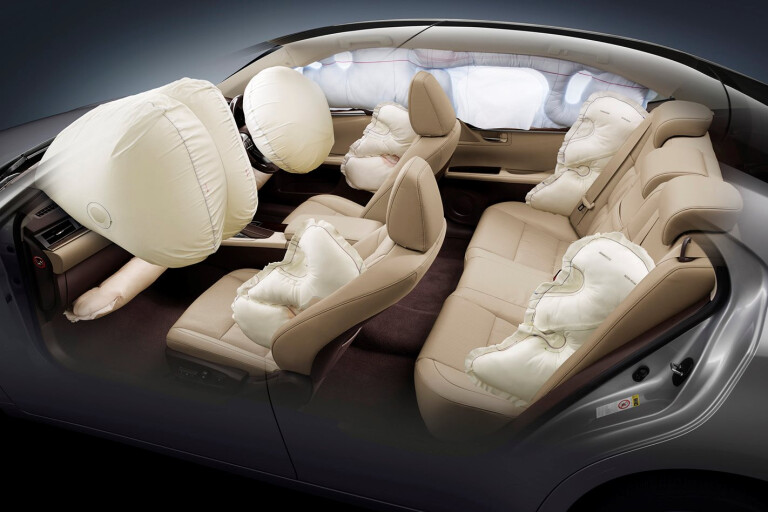
How do airbags work?
Airbag units are equipped with ‘satellite sensors’ that activate the inflator in a severe frontal collision at speeds in excess of 24km/h. The inflator ignites a chemical mix of sodium azide (NaN3) and potassium nitrate (KNO3) to create a pulse of nitrogen gas that rapidly inflates a thin nylon bag.
As the bag inflates it pushes its way out from between a split in the cover so none of the steering wheel, dashboard or other surface in front hits your face or body. As your head or body meets the airbag it cushions the impact by deflating through holes at the base.
The driver-side airbag ignites and inflates in 20-30 milliseconds, or less than half the time it takes to blink your eyes. The passenger bag takes 30-40 milliseconds.
Airbags are designed to deploy at a collision speed above 25km/h and when the angle of impact is about 30 degrees on either side of the car’s direction – this means frontal airbags won’t deploy in the event of a side impact or rollover.

Where are airbags fitted?
Airbags were first fitted within steering wheel hubs to protect the driver during a front-on collision, but now they can be mounted throughout the car to protect front and rear occupants in a variety of situations, including side impact and rollover events. Some cars have up to nine airbags, though there’s no actual minimum requirement as they are officially classified as supplementary safety equipment and aren’t mandatory, like seatbelts.
- Frontal airbags: Originally fitted at the front of the car to protect the driver from a forward collision and were mounted in the steering wheel. Front passenger airbags were later introduced and fitted into the dashboard.
- Knee airbags: Deploys in frontal collisions to protect the front occupants’ knees from hitting the steering column and dash.
- Side airbags: Deploys on impact in side collisions and possibly during rollovers.
- Footbags: Deploys into the foot well to reduce injuries to the feet and lower legs.
- Curtain airbags: Inflates downwards from the roof sill to protect the occupant’s head and remains inflated.
- Side torso airbags: Deploys from the side of the seat upwards and remains inflated.
- Seatbelt airbags: Deploys from the seatbelt across the torso and shoulder.
The Australasian New Car Assessment Program (ANCAP) recommends airbags that protect the head, neck, face, and thorax in front and side crashes. This means frontal, side, and curtain airbags should be on your list.
Airbag issues
- Airbags are designed to mitigate injury in a crash and not prevent it. Minor injuries such as bruises and scratches after contact with the bag are common, but that’s a small price to pay to prevent the full force of a significant impact.
- Wearing glasses doesn’t present any danger of facial injuries if the occupant is at the normal distance from the steering wheel or dashboard.
- Airbags are designed for people sitting and driving in a proper position, so don’t sit with your feet on the dashboard, and when driving, avoid placing your hands on the steering wheel’s hub as you could end up punching yourself pretty hard should the airbag deploy.

- Airbags are designed for adult-sized people. Children are at risk of serious injury from a deploying frontal airbag, so avoid having kids in the front seat even if they are in a child seat. Check the front airbag is OFF if you have a child under 13, or a person less than 153 cm tall, in the front passenger seat.
- Don’t place objects or accessories in the car that may prevent the deployment of the airbag or become projectiles when the airbag goes off, such as phone holders, covers, pictures, clocks, magnets, and mats. Seat covers can obstruct the deployment of seat-mounted side airbags as well.
- If you get an airbag warning light in your dashboard take the car to your dealer or mechanic as it could mean the airbag is faulty. Don’t attempt to fix it yourself.
- Bull bars or roo bars can affect airbag operation, and can only be fitted if it is certified by the vehicle's manufacturer as being safe for that vehicle. Aftermarket bars can only be fitted if manufacturer can prove they won’t detrimentally affect the performance of the airbag system.
- If you have an SUV with curtain airbags, check that it also has a rollover sensor.
- Read your manual and understand what your airbags can and can’t do, and where they are located.
- Find out if your vehicle is subject to the massive Takata airbag recall that affects more than a million vehicles worldwide.

COMMENTS